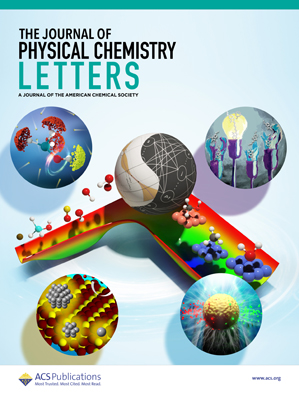光激发硫化镉纳米晶体中表面羧酸盐对电子和空穴弛豫的敏感性
IF 4.6
2区 化学
Q2 CHEMISTRY, PHYSICAL
引用次数: 0
摘要
了解钝化表面配体如何与纳米晶体光催化剂中的激子态耦合对于控制与界面电荷转移竞争的非辐射弛豫途径至关重要。在这里,我们报告了飞秒瞬态红外(IR)光谱来解析油酸覆盖的硫化镉(CdS)纳米晶体中1S激子态之间的配体-激子耦合和表面羧酸盐的振动模式。差分中红外光谱分别在~ 1540 cm-1(羧酸盐不对称拉伸)和~ 1440 cm-1(羧酸盐对称拉伸)处显示出明显的负振幅和正光诱导吸收信号。瞬态红外测量表明,对称拉伸对皮秒俄歇复合非常敏感,而非对称拉伸则没有类似的衰减。我们的研究结果提供了CdS纳米晶体中飞秒配体-激子耦合的直接测量,并展示了表面结合的羧酸配体如何作为纳米晶体光物理的载流子特异性报告者。这些发现为设计和开发下一代纳米晶体光催化剂中配体介导策略的预测模型提供了重要的见解。本文章由计算机程序翻译,如有差异,请以英文原文为准。

Surface Carboxylate Sensitivity to Electron and Hole Relaxation in Photoexcited Cadmium Sulfide Nanocrystals
Understanding how passivating surface ligands couple to excitonic states in nanocrystal photocatalysts is crucial for controlling nonradiative relaxation pathways which compete with interfacial charge transfer. Here, we report femtosecond transient infrared (IR) spectroscopy to resolve ∼100 fs ligand-exciton coupling between 1S exciton states in oleate-capped cadmium sulfide (CdS) nanocrystals and vibrational modes of surface carboxylates. Differential mid-IR spectra show distinct negative amplitude and positive photoinduced absorption signals at ∼1540 cm–1 (carboxylate asymmetric stretch) and ∼1440 cm–1 (carboxylate symmetric stretch), respectively. Fluence-dependent transient IR measurements reveal that the symmetric stretch is uniquely sensitive to picosecond Auger recombination, while the asymmetric stretch shows no analogous decay. Our results provide direct measurement of femtosecond ligand-exciton coupling in CdS nanocrystals and demonstrate how surface-bound carboxylate ligands serve as carrier-specific reporters of nanocrystal photophysics. These findings offer critical insights for designing and developing predictive models for ligand-mediated strategies in next-generation nanocrystal photocatalysts.
求助全文
通过发布文献求助,成功后即可免费获取论文全文。
去求助
来源期刊

The Journal of Physical Chemistry Letters
CHEMISTRY, PHYSICAL-NANOSCIENCE & NANOTECHNOLOGY
CiteScore
9.60
自引率
7.00%
发文量
1519
审稿时长
1.6 months
期刊介绍:
The Journal of Physical Chemistry (JPC) Letters is devoted to reporting new and original experimental and theoretical basic research of interest to physical chemists, biophysical chemists, chemical physicists, physicists, material scientists, and engineers. An important criterion for acceptance is that the paper reports a significant scientific advance and/or physical insight such that rapid publication is essential. Two issues of JPC Letters are published each month.
 求助内容:
求助内容: 应助结果提醒方式:
应助结果提醒方式:


